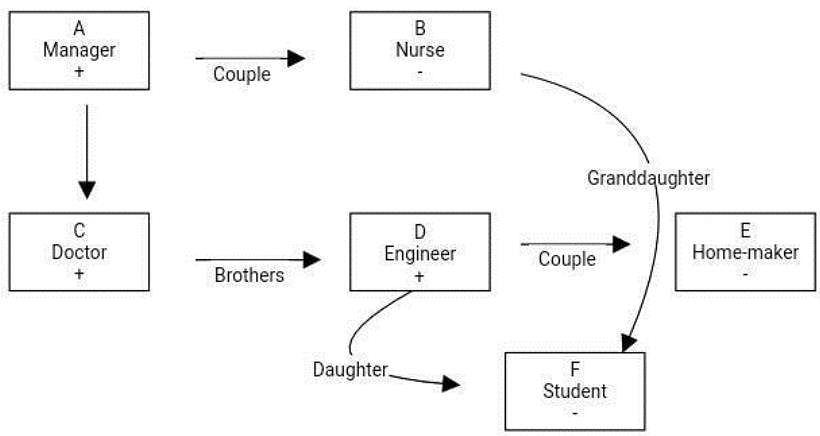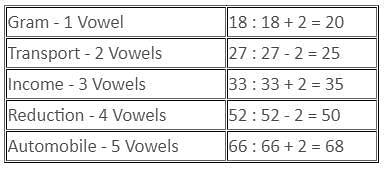SSC CGL (Tier II) Practice Test - 13 - SSC CGL MCQ
30 Questions MCQ Test SSC CGL Tier II Mock Test Series 2024 - SSC CGL (Tier II) Practice Test - 13
Study the following table and answer the questions.
Number of Candidates Appeared and Qualified in a Competitive Examination from Different States Over the Years.

What is the average candidates who appeared from State Q during the given years?
Number of Candidates Appeared and Qualified in a Competitive Examination from Different States Over the Years.

What is the average candidates who appeared from State Q during the given years?
The following line graph gives the ratio of the amounts of imports by a company to the amount of exports from that company over the period from 1995 to 2001.

The imports were minimum proportionate to the exports of the company in the year ?
| 1 Crore+ students have signed up on EduRev. Have you? Download the App |
Statements :
I. In the code language, 'shi tu ke' means 'pen is blue'.
II. In the same code language, 'ke si re' means 'this is wonderful'.
Q. What is the code for 'is' in the code language ?
I. In the code language, 'shi tu ke' means 'pen is blue'.
II. In the same code language, 'ke si re' means 'this is wonderful'.
Statements :
I. A and D are heavier than B, E and F but none of them is the heaviest.
II. A is heavier than D but lighter than C.
Q. Among A, B, C, D, E and F, who is the heaviest ?
Two Inlet Pipes A and B together can fill a Tank in ‘X’ minutes. If A and B take 81 minutes and 49 minutes more than ‘X’ minutes respectively, to fill the Tank. Then They can fill the 5/7 of that Tank in how many minutes?
Directions to Solve
In each word of the following questions consists of pair of words bearing a relationship among these, from amongst the alternatives, pick up the pair that best illustrate a similar relationship.
Question -
Lively : Dull
Directions: In this question below is given a statement followed by two assumptions numbered I and II. Consider the statement and decide which of the given assumptions is implicit.
Statement:
One should make notes from the newspaper everyday for an efficient preparation of current affairs.
Assumptions:
I. One cannot prepare for current affairs efficiently without reading newspapers.
II. Making notes helps in an efficient preparation of current affairs.
Directions: Read the information given below to answer the question.
Rani and Shreshtha are a married couple having two daughters, Medha and Deepti. Deepti is married to Anurag, who is the son of Garima and Tarun. Nidhi is the daughter of Anurag. Komal, who is Anurag's sister, is married to Harshit and has two sons, Aman and Prem. Prem is the grandson of Garima and Tarun.
Q. What is the relation between Aman and Nidhi?
Directions: Read the following information carefully and answer the question that follows.
A, B, C, D, E and F are members of a family. E is the sister-in-law of the Doctor, F is the granddaughter of the Manager's wife. C is the son of the Nurse. D is married to the Homemaker and is the father of F. C is the paternal uncle of F. One of the unmarried male members' siblings is an Engineer. B is not the father of D. The Student is not married.
Q. What is the profession of D?
Directions: The given question is on the basis of following information.
A number and word arrangement machine, when given an input line of words and numbers, re-arranges them by undertaking a specific rule in every step. Given below is the illustration of an input and its steps of re-arrangement.
Input: 58 Education 42 Rid 17 Mountain Cinema 23 Complex 6
Step I - Rid 58 Education 42 17 Mountain Cinema 23 Complex 6
Step II - Rid 8 58 Education 42 17 Mountain Cinema 23 Complex
Step III - Rid 8 Complex 58 Education 42 17 Mountain Cinema 23
Step IV - Rid 8 Complex 15 58 Education 42 Mountain Cinema 23
Step V - Rid 8 Complex 15 Cinema 58 Education 42 Mountain 23
Step VI - Rid 8 Complex 15 Cinema 25 58 Education 42 Mountain
Step VII - Rid 8 Complex 15 Cinema 25 Mountain 58 Education 42
Step VIII - Rid 8 Complex 15 Cinema 25 Mountain 40 58 Education
Step IX - Rid 8 Complex 15 Cinema 25 Mountain 40 Education 58
Step X - Rid 8 Complex 15 Cinema 25 Mountain 40 Education 60
Here, step X is the final step of the given input.
Input for the question is given below.
Input: 66 Automobile 52 Gram 27 Reduction Income 33 Transport 18
Q. Which of the following will be the third step of the given input?
Directions: The given question is on the basis of following information.
A number and word arrangement machine, when given an input line of words and numbers, re-arranges them by undertaking a specific rule in every step. Given below is the illustration of an input and its steps of re-arrangement.
Input: 8 Camera 3 12 Stardom Umbrella 11 Orange 21 23 Public Apple
Step I - Apple 3 8 Camera 12 Stardom Umbrella 11 Orange 21 23 Public
Step II - Apple 3 8 Camera 12 Umbrella 11 Orange 23 Public Stardom 21
Step III - Apple 3 Orange 11 8 Camera 12 Umbrella 23 Public Stardom 21
Step IV - Apple 3 Orange 11 8 Camera Umbrella 23 Public 12 Stardom 21
Step V - Apple 3 Orange 11 Umbrella 23 8 Camera Public 12 Stardom 21
Step VI - Apple 3 Orange 11 Umbrella 23 Camera 8 Public 12 Stardom 21
Here, step VI is the final step of the given input.
Input for the question is given below:
Input: Ice-cream 18 Elephant 6 31 Brain 12 Praise Owl 13 23 Train
Q. In step III, 'Ice-cream' is related to '31' and in the same way, '13' is related to '31' in step II. In the same way, which of the following elements is related to 'Owl' in step V?
Directions: Read the passage carefully and answer the question given below.
A golden age for Western schools in China may be coming to an end in the face of a new government clampdown.
China has been a happy hunting ground for Western schools in recent years, as a burgeoning middle class looks to equip their children with the qualifications to get into a Western university, as well as the skills to join a global workforce.
The last five years has seen a 64% increase in the number of students enrolled in international schools in China, which now account for 372,000 children in 857 schools.
But from next year, schools will have to select their students via a lottery, rather than being able to pick and choose from among the applicants.
The crackdown has been prompted by fears that foreign-owned schools are poaching the brightest children, according to Richard Gaskell, director of international education analysts ISC Research.
The move follows changes introduced last year requiring international schools to teach the Chinese curriculum alongside other national programs.
‘There is a backlash against the rapid increase in private schools in China, particularly from the big public schools where it’s perceived that they have been simply creaming off the best kids,’ Mr Gaskell said.
Foreign-owned schools should also expect greater scrutiny and bureaucracy, he added.
International schools should put expansion plans on hold until the full effect of the changes becomes apparent next spring, he told the Headmasters’ and Headmistresses’ Conference of leading fee-paying schools in the U.K.
The Chinese government was also concerned at the number of students heading abroad to study, both at K-12 level and for higher education, he added.
The international schools market has exploded in China in recent years, after the authorities relaxed regulations so that Chinese children could attend foreign-owned schools.
Until then, international schools almost entirely served the children of foreign nationals, but opening them up to Chinese children revealed a massive and previously untapped demand.
For the growing Chinese middle class, the schools provided a more reliable route than Chinese national schools for getting into highly-regarded universities in the West, particularly those in the U.S. and U.K.
These students, in turn, represent a lucrative source of income, for both the schools themselves and for Western universities. The annual fee for a leading international school is around 280,000 yuan, or $39,000.
China is the largest source of international students at U.K. universities, accounting for more than one in five at undergraduate and postgraduate level.
Some of the most prestigious private schools have sought to capitalise on their brand by opening branches in China in recent years. Wellington College has five schools in China - two each in Shanghai and Hangzhou and one in Tianjin - while Dulwich College has four - two in Shanghai and one each in Beijing and Suzhou.
A record 14 British international schools have opened or are due to open in China this year, including outposts of the King’s School, Canterbury, and Shrewsbury School, which counts Charles Darwin among its alumni.
But despite the increased scrutiny, Mr. Gaskell said there are still opportunities for international schools to open in China, given the "massive demand" among Chinese families.
"There is a deep desire amongst the wealthy, middle class and young Chinese parents for a Western style of education," he said.
Parents want an international education but also want their children to retain their culture and identity, he added, as well as excellent exam results and "places at the top universities."
Q. Which of the following statements is/are not true with respect to the passage?
According to the Bible / it is meek and humble / who shall inherit the earth / No error.
Find the word most appropriate for Blank no. 15
The (11)____ citizen who has to get everyday jobs done by various municipal and government departments is (12)____ driven up a tree, first (13)____ them, second explaining to them what is (14)____ and lastly, getting the job done.
If this week I (15)____ some personal experience in this column, it is because I can document them. It is not to ask for any special (16)____ or voice personal (17)____ but to bring into public view the experience of hundreds, if not thousands of citizens everyday of the year and express the collective (18)____ of all of them. Because one’s usual experience is that when such complaints are (19)____ in such columns, the departments rush to (20)____
DIRECTIONS: The following question contains an idiom and its usage in a sentence, followed by five possible meanings labelled A, B, C, D and E. Pick out the right meaning of the idiom in question and mark your answer accordingly.
Q.
On the wane.
The days of this actor are "on the wane".
Directions: Read the following passage carefully and answer the questions given beside.
Remote sensing and GIS are promising tools for handling spatial and temporal data and help in integrating them for successful planning of natural resources. It is the science of measuring the earth using sensors mounted on high-flying aircrafts or satellites. These sensors collect data in the form of images and provide insights for manipulating, analysing and visualising those images. Since natural resources are not uniformly distributed and are spatially varied, it is challenging to capture the correct picture. Management of natural resources calls for scientific tools for timely and accurate dissemination of information. In natural resource management, remote sensing and GIS are mainly used in the mapping process. These techniques are useful in management of land, soil, coastal, watershed, urban and many more.
In India, the agriculture sector alone sustains the livelihood of around 50 percent of the population. Therefore, an increase in crop productivity has been a major concern. Since, the scope for increasing area under agriculture is limited, advanced crop production forecasting is required for better policymaking. Indian Space Research Agency (ISRO) and Indian Council of Agricultural Research (ICAR) successful experiment-Agricultural Resource Inventory and Survey Experiment (ARISE) used aerial colour photographs to estimate crop acreage in many states of India. Other Important uses of remote sensing include crop identification, stress detection, and crop yield modelling, drought monitoring, land degradation mapping and more. Urbanisation is important and inevitable for development, but its proper planning and management is crucial for sustenance. One of the important features of GIS is multilayered mapping. This kind of mapping helps municipal corporations, town planning boards to build cities that are better organised. The information systems with socio-economic data overlaid upon satellite data makes urban planning cost-effective and accurate.
Coastal ecosystems have high ecological significance. GIS and remote sensing data are used to study coastal ecosystems and marine living resources which include habitats like mangroves, coral reefs and more. Apart from this, suspended shoreline dynamics can be studied and climatic changes leading to cyclones and sea level rise may be of special interest too. Geospatial data is effective in the analysis and determination of factors that affect the utilisation of these resources. The technologies provide a platform through which we can generate information that can be used to make sound decisions for sustainable development of the natural resources of India.
Q. How effective are remote sensing and GIS in managing urban growth?
I. GIS and remote sensing are helpful in building cities that are better organized.
II. The system makes urban planning cost-effective and accurate.
III. They help the government disseminate people living in extremely densed areas to less populated ones.
Directions: In the given statements, a blank has been given. This needs to be filled up using the correct combination of words from the three options mentioned, so that the resulting statement is grammatically and contextually correct.
In the ancient times, remaining alone was dangerous as _______________ animals could easily attack its solitary prey.
I. domesticated
II. wild
III. herbivorous
Direction: The sentences given in the question, when properly sequenced, form a coherent paragraph. Each sentence is labeled with a letter. Choose the most logical order of sentences from the given choices to construct a coherent paragraph.
A. As people turned to farming, they began to live in fixed settlements, which became small towns.
B. Their labors bore fruit; surplus food freed some of the population from farming.
C. In about 5000 BC, farmers moved down into the fertile river valleys of Mesopotamia, and built dykes and ditches to irrigate the arid land.
D. The cultivation of plants, such as wheat and barley, and the domestication of animals, such as sheep, goats and cattle, began in the Near East in about 8500 BC.
Directions: Read the following passage carefully and answer the questions given beside.
A powerful cyclonic storm named Fani (pronounced Foni) is headed towards the Odisha coast, with its landfall forecast near Puri Friday. Expected to generate storms with wind speeds as high as 200 km per hour, it has the potential to cause widespread damage in Odisha and neighbouring states. The last time such a powerful cyclonic storm had emerged in the Bay of Bengal at this time of the year, in 2008, it had killed more than 1.25 lakh people in Myanmar. But that was mainly because of the lack of a sophisticated warning system and enough logistical preparedness to evacuate people.
Fani, on the other hand, has been continuously monitored ever since it developed in the southeast of Sri Lanka about a week ago, warnings have been issued after every few hours to fishermen and people living in coastal regions, and a massive emergency preparedness has been mounted. In the last few years, India has impressively managed disasters caused by cyclones, most remarkably during Cyclone Phailin of 2013, which was even stronger than the approaching Fani.
The eastern coast of India is no stranger to cyclones. On an average, five to six significant cyclonic storms emerge in the Bay of Bengal region every year. The months of April and May just before the start of the monsoon, and then October to December immediately after the end of the monsoon, are the prime seasons for tropical cyclones.
Q. Which of the following is true with respect to the passage?
I. Phailin was weaker than Fani.
II. The disaster management failed to managed cyclones like Phailin.
III. Fani has been continuously monitored since its beginning.
The Vitamin which helps in clotting of blood is :
Before the Bretton Woods standard system, exchange rates were pegged against ______
The Reserve Bank of India has decided to help banks as a temporary measure, by providing additional liquidity support under LAF. What does LAF stand for?
Which computer was built before the First Generation Computer?
Which of the following programming languages is an object-oriented language?
A telephone number, a birth date, and a customer name are all examples of
Which of the following is the key function of a firewall?
|
66 docs|140 tests
|
|
66 docs|140 tests
|















